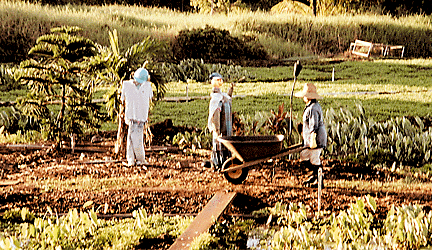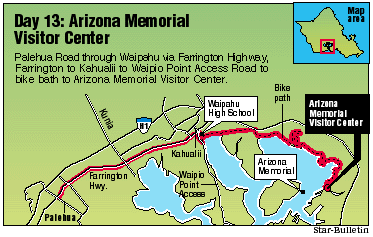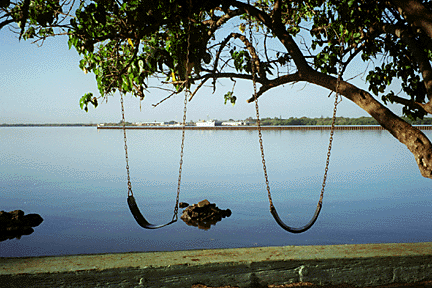

WALKING STORIES

Busy bike path
By Cynthia Oi
skirts Pearl Harbor
Star-Bulletin
Day 13: Palehua Road to Arizona Memorial Visitors Center, 10.3 miles.The cab driver is wary of dropping me near the unmarked road intersecting a deserted stretch of Farrington Highway between Makakilo and Waipahu.
"No look safe," he says. I assure him it will be OK, but he looks puzzled as to why anyone would choose this destination. He insists that I get off, instead, at Kapolei Golf Course. His concern is genuine, so I agree, even though it will add about a half-mile to my journey.
After the lights of the taxi recede, I am glad I listened to him. Besides the golf course sign, I can see little in the darkness. I decided to start off early on this, the last of my walking segments. Maybe it was a bit too early.
As I head toward Waipahu, a flashing yellow light at a tight curve serves as a beacon. A few vehicles, mostly trucks, wind along the two-lane road. I am so alone.

I don't notice the sky lighten, but when I next look up, I see the Koolaus and the skyline of Waikiki with Diamond Head hazy behind it. In that light, from that distance, it looks like Oz.Behind me, the foothills of the Waianae Range level off, the land stretching flat toward the sea. Fields wild in kiawe suddenly become cultivated. Strips of plastic laid between neat rows of plantings shimmer as the sun clears the few clouds on the horizon. Huge green pipes -- for irrigation, I guess -- heave into view, appearing like legs of prehistoric beings stuck in the dirt.
Near the Kahi Mohala facility, a green oasis in the arid scrubbiness of the surrounding area, the road curves and the lights of Waipahu town look welcoming.
My enthusiasm is short lived. The blight of urban sprawl has withered Waipahu, once a town with some character. Grimy strip malls, most of them rundown, slump along the highway. Car lots, auto parts stores, industrial buildings, tire centers and pawn shops crowd in between. Fast food rules here: KFC, Zippy's, McDonald's, Arby's and Jack-in-the-Box stand shoulder to shoulder with local-food drive-ins, like Brandi's.
In what's left of our island paradise, Waipahu seems purely utilitarian; you go there because you need to, not for fun or sightseeing. In fact, I see no tourist rental pods, no tour buses, no "scenic view" signs anywhere.

What Waipahu does appear to have, however, is lots of people. Most of them seem to be waiting for the bus in the early morning. In my trek around Oahu, I've never seen so many people at bus stops than in Waipahu. At one shelter, I counted 21.Merinda rides the bus to town Sunday through Thursday to get to her job at a Waikiki hotel. When asked if she likes living in Waipahu, she seems surprised by the question, as though she's not thought of it before. She frowns, then shrugs. "It's OK, I guess," she says. "I pay low rent, not like rent in town."
At the bus stop in front of Waipahu High School, teenagers gather, smoking cigarettes and talking, talking, talking as they wait for school to start.
One fellow warns about heading down the bike path that starts in back of the school. "Watch out for the bums if you go there," he says. His friend punches his arm. "No more bums," he says, wiggling his eyebrows. "Get homeless bums." They chortle and engage in a choreography of high fives, knocking elbows and fists, and bumping chests.
The bike path doesn't appear to shelter the homeless but bikers, joggers and walkers abound. The paved trail appears benign. Water fowl caw and flap in the marshy plants growing in inland waterways. Lavender blossoms push their way through thick vines.
The hints of danger come not from bums, but from the signs that line the pathway. Every few hundred yards, Chevron and later Tesoro warn of a petroleum pipeline, listing numbers to call in case of an emergency. Health department signs warn fishermen against eating anything caught in Pearl Harbor waters.
A biker who didn't heed or maybe didn't see the "slippery when wet" signs near the Hawaiian Electric power plant skids off the path into the brush, but recovers before falling.
Despite unseen dangers, the path is a welcome respite from the furor of vehicles on the highway. It skirts Middle Loch and cuts through the base of Pearl City Peninsula, revealing a part of Oahu few people see. For the first two miles, the gray-green harbor waters mirror the ships and dry docks. Vines and trees of all varieties shade users.
After Lehua Avenue, nature crashes into the modern world. The path winds behind aluminum industrial structures, car dealerships and a spitting, steaming petroleum plant.
Still, in all of this, there are pockets of peace. Beneath the concrete uplift of the highway, Alice Kobashigawa pushes a wheel barrow along the dikes that separate paddies of watercress and taro. She and her husband Seijun work the three-quarter acre farm much like Seijun's father did a century ago.
On this day, Kenneth Sugai is slip-sliding his way down an embankment to where Alice is harvesting cress. He holds out a plastic bag he found in the litter of a huge banyan tree up the path and she fills it with fresh-cut vegetables.
"I saw this place before," Sugai says, "but they were faraway, working on the other side, so I couldn't talk to them. When I saw them on this side today, I thought, buy some -- you cannot get any fresher." Pleasure radiates from his face. "Cheap, you know. One dollar for all this."
Sugai lives in McCully and uses the bike path when he drops his car off at Cutter Ford for servicing.
"While I'm waiting, I figure I might as well walk for about a hour."
He used to take Farrington Highway, but the traffic and fumes were "too much. Then I notice all these people going back here, so now I walk here. This is nice."
It is, when the alternative is a busy highway. Near McGrew Point, the path swings through the Aiea Bay Recreation Area and under Kamehameha Highway. It dwindles as it crosses Navy land (signs warn that you are on official U.S. Government Property), runs past Pearl Harbor Yacht Club and under the new Ford Island bridge.
As the path changes to parking lots at the Arizona Memorial, so does the atmosphere. The bedraggled Waipahu-Pearl City-Aiea town scenes give way to the sterile, straight-lined structures of the memorial.
The bus riders also are gone, replaced by camera-toting, baseball-capped, "I Love Tennesee"-T-shirted visitors, hustling to get in line first. The lots are full of grape and neon-green compact cars and gassy tour buses.
What a difference five miles make.
Click for online
calendars and events.